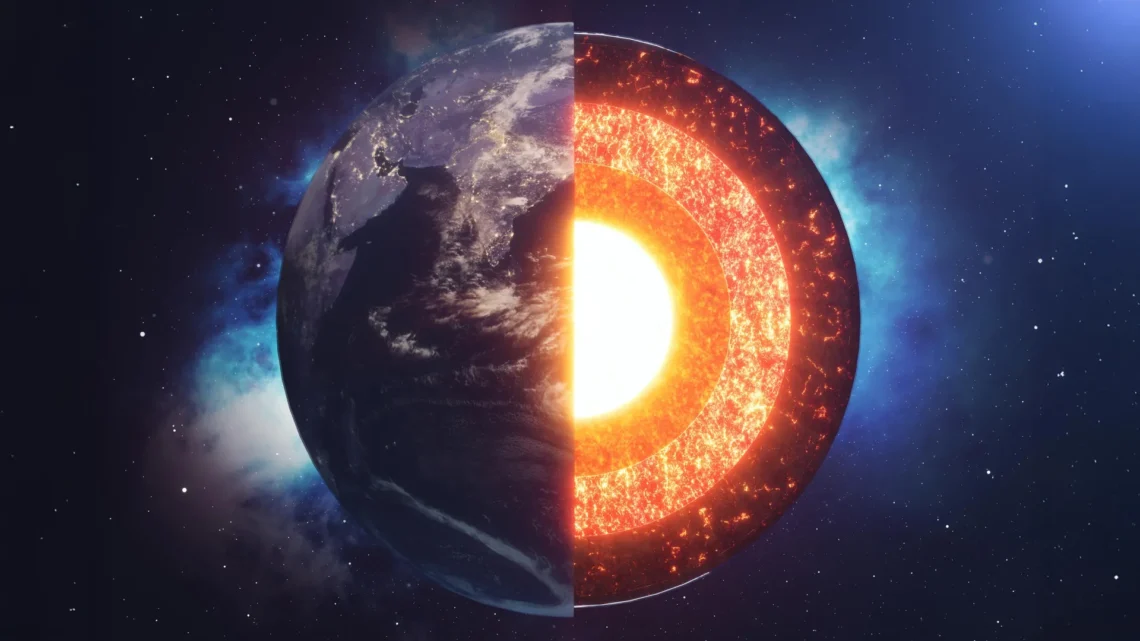Diamonds from South Africa’s Voorspoed mine have provided the first natural evidence of nickel-rich metallic alloys forming deep within Earth’s mantle, at depths of 280-470 km (174-292 miles). A new study demonstrates that these inclusions coexist with nickel-rich carbonates, capturing a rare snapshot of a “redox-freezing” reaction, where oxidized melts infiltrate reduced mantle rock. The growing diamond encapsulated both reactants and products of the diamond-forming reaction. This discovery confirms long-held predictions about mantle redox conditions and sheds light on how such processes can fuel the formation of diamond-rich volatile magmas that ultimately erupt from deep within the Earth.
The Earth’s mantle is a dynamic and complex system that drives volcanism, recycles crust, and shapes the long-term evolution of our planet. However, one of its most challenging aspects to study is the redox state—the balance between oxidized and reduced chemical species. A new study by researchers Yael Kempe and Yaakov Weiss from the Hebrew University’s Institute of Earth Sciences offers an intriguing look into these deep processes, revealed through tiny inclusions in diamonds from the Voorspoed mine in South Africa.
A Rare Discovery in the Depths
For many years, scientific models and high-pressure experiments have suggested that nickel-rich metallic alloys should stabilize at depths of around 250-300 km in the mantle. Yet, natural samples confirming these predictions have been extremely rare.
Collaborating with researchers from the University of Nevada, the University of Cambridge, and the Nanocenter at the Hebrew University, Weiss’s team has successfully identified nickel-iron metallic nanoinclusions and nickel-rich carbonate microinclusions within diamonds that formed between 280-470 km below the Earth’s surface. These inclusions mark the first direct evidence of nickel-rich alloys at the depths predicted by theory, a long-sought validation of mantle redox models.
The diamonds also carried a variety of minerals, including coesite, potassium-rich aluminous phases, and solid nitrogen inclusions, providing strong evidence of their origin in the deep upper mantle and shallow transition zone.
Redox Snapshots Frozen in Carbon
The significance of this discovery goes beyond merely confirming existing theories. The presence of both nickel-iron alloy and nickel-rich carbonate indicates a metasomatic redox-freezing reaction, involving the infiltration of oxidized carbonatitic-silicic melt into reduced mantle rock containing metal. This adds to previous evidence suggesting that this process is key to the natural formation of diamonds.
In this environment, the preferential oxidation of iron compared to nickel led to the enrichment of the residual alloy in nickel. At the same time, nickel-rich carbonates and diamonds crystallized from the melt. Essentially, these diamonds have captured a fleeting geochemical moment: the transformation of reduced mantle rock into a more oxidized, volatile-rich zone, and the subsequent conversion of carbonates into diamonds.
“This is a rare snapshot of mantle chemistry in action,” states Weiss. “The diamonds act as tiny time capsules, preserving a reaction that would otherwise be lost as minerals re-equilibrate with their surroundings.”
Implications for Mantle Dynamics and Magmatism
These findings have far-reaching implications. If localized metasomatic reactions periodically oxidize small portions of the mantle, this may help explain why some inclusions in other superdeep diamonds show unexpectedly high oxidized conditions.
Additionally, these processes may clarify the origins of volatile-rich magmas. The enrichment of mantle peridotite in carbonate, potassium, and other incompatible elements during these redox events could set the stage for the later formation of kimberlites, lamprophyres, and even certain ocean island basalts. In other words, the tiny inclusions found in Voorspoed diamonds hint at a deeper connection between subduction processes, mantle redox dynamics, and the generation of magmas that form continents and bring diamonds to the surface.
Diamonds as Mantle Witnesses
This study highlights the scientific importance of diamonds as more than just precious stones. Their inclusions—whether tiny metallic alloys or high-pressure minerals—provide one of the few natural records of conditions located hundreds of kilometers beneath our feet.
Kempe and Weiss’s work represents a major milestone: the first natural confirmation of nickel-rich alloys at mantle depths predicted by theory and a vivid demonstration of how the deep Earth’s redox landscape changes through melt-rock interactions.
As researchers continue to explore these mineral time capsules, we may discover that diamonds, which symbolize permanence, are also storytellers of change—documenting the hidden chemistry of the mantle and the ongoing processes that shape our dynamic planet.





